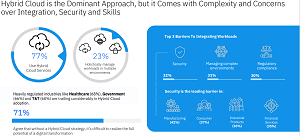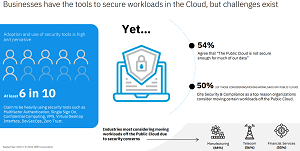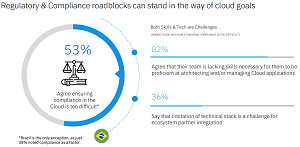News
IBM Cloud Study: 'Initial Excitement' Bends to Skills, Security, Compliance Challenges
A new cloud study from IBM tells a familiar story: Organizations are choosing the hybrid model to drive digital transformations but are hindered by factors including a lack of skilled technologists, security concerns and overwhelming compliance/regulatory burdens.
The IBM Transformation Index: State of Cloud report, based on a survey conducted by an independent research firm, is designed to help organizations assess their own state of cloud, an effort that will be aided by an upcoming interactive tool to help them measure progress.
That effort, however, starts with collecting data, which in this case comes from an online survey conducted in June/July in 12 countries that polled 3,014 IT and business professionals in companies with annual revenue over $500M who have deep knowledge of their organization's cloud strategy.
One key highlight of the survey is the choice of the hybrid cloud computing model, a mix of public cloud, private cloud and on-premises infrastructure. The report reveals that 77 percent of respondents reported using hybrid cloud services, with 71 percent agreeing that it's difficult to to realize the full potential of a digital transformation.
 [Click on image for larger view.] Hybrid Popularity (source: IBM).
[Click on image for larger view.] Hybrid Popularity (source: IBM).
That finding jives with a May report from Cisco that described hybrid cloud as the "new normal," indicating 82 percent of survey respondents have adopted hybrid cloud. It also aligns with a December 2021 survey-based report from NetApp that found the future is hybrid cloud, with more than three-quarters of respondents saying their organization plans to operate a hybrid cloud environment for the foreseeable future.
Noting that a majority of companies have now embraced hybrid cloud, IBM said, "We expect this trend to continue as 80 percent are moving workloads from public clouds back to some form of private infrastructure. Top reasons are to improve performance and latency, security, and compliance."
Indeed, the latter two items on that list are also two of the three major cloud computing challenges faced by organizations, along with the seemingly permanent lack of professionals with requisite cloud skills. Those three major challenges are summed up verbatim by IBM:
Lack of the Right Skills Is Inhibiting Progress
When it comes to managing their cloud applications, 69 percent of respondents say their team lacks the skills needed to be proficient. This is a major roadblock to innovation, with more than a quarter of respondents saying skills and talent shortages are impeding their business's cloud objectives. The effects don't stop here -- these limitations are also preventing organizations from leveraging the power of partnerships. More than one-third of respondents say a lack of technical skills is holding them back from integrating ecosystem partners into cloud environments. This challenge is even greater in the US, where nearly 40 percent admit to this lack of skills -- pointing to the need for talent.
 [Click on image for larger view.] Skills Dearth (source: IBM).
[Click on image for larger view.] Skills Dearth (source: IBM).
Exposure to Cyberthreats Continues to Lurk Despite Embracing Security Techniques
While more than 90 percent of responding financial services, telecommunications and government organizations have adopted security tools such as confidential computing capabilities, multifactor authentication and more, gaps remain that are preventing organizations from driving innovation. In fact, 32 percent of overall respondents cite security as the top barrier for integrated workloads across environments and more than one quarter of respondents agree security concerns present a roadblock to achieving their cloud business goals.
 [Click on image for larger view.] Security Challenges (source: IBM).
[Click on image for larger view.] Security Challenges (source: IBM).
Security concerns can even hold organizations back from unlocking the full potential of partnerships. As potential security gaps can cause third and fourth party risks to loom, respondents say data governance (49 percent) and cybersecurity (47 percent) are the top challenges to fully integrating their business ecosystem into the cloud. In Brazil, cyberthreats are an even greater concern to ecosystem innovation -- 51 percent say cybersecurity risks pose a major challenge for businesses that want to integrate business ecosystem partners into cloud environments.
Regulatory and Compliance Requirements Remain Center Stage Causing Businesses to Pause
With regulations on the rise, so too are compliance challenges. 53 percent of respondents believe that ensuring compliance in the cloud is currently too difficult and nearly one-third cite regulatory compliance issues as a key barrier for integrating workloads across private and public IT environments. In financial services, for example, more than a quarter of respondents agree that meeting industry requirements is holding them back from fully achieving their cloud objectives. These challenges span the globe and are especially prevalent in countries such as Singapore, China, India and Japan.
 [Click on image for larger view.] Red Tape Roadblocks (source: IBM).
[Click on image for larger view.] Red Tape Roadblocks (source: IBM).
'Initial Excitement' Wanes
"When companies first started migrating to cloud they assumed it would give them scalability, reduce costs and reduce technical debt," IBM said in a Sept. 29 blog post. "However, for this to happen, organizations must first determine how they want to connect the cloud assets and the rest of their estate to enable new ways of working. Adding more clouds does not address business objectives; companies need to create a solid hybrid cloud strategy that helps deliver the capabilities needed to achieve the business outcomes."
Furthermore, the company said: "The initial excitement with respect to cloud is now shifting toward businesses partnering with the CIO, asking questions such as:
- Why should I move to cloud?
- How will it accelerate achieving my business objectives?
- What capabilities do I need before I can leverage the cloud?
- Which applications are best suited to move, modernize or build new?
Based on the transformation index, IBM said it will in the coming months launch an interactive tool to serve as a continual source of feedback for organizations to measure their transformation progress. It might even help them answer those questions.
About the Author
David Ramel is an editor and writer at Converge 360.